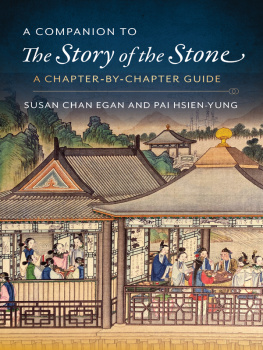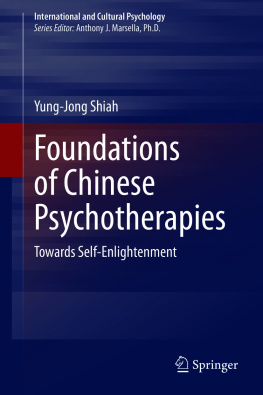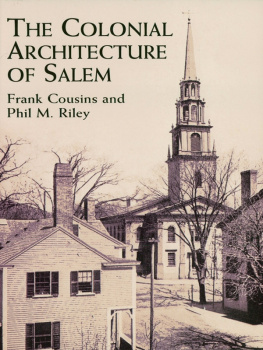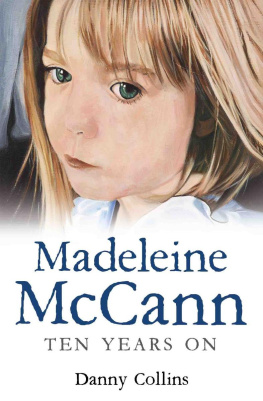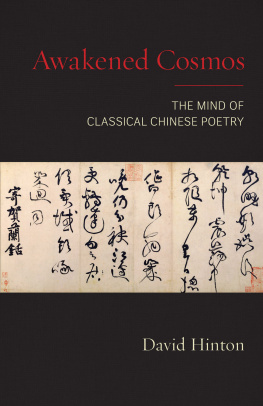Table of Contents
A COMPANION TO
The Story of the Stone
A COMPANION TO
The Story of the Stone
A CHAPTER-BY-CHAPTER GUIDE
SUSAN CHAN EGAN
AND PAI HSIEN-YUNG
Columbia University Press
New York
Columbia University Press
Publishers Since 1893
New York Chichester, West Sussex
cup.columbia.edu
Copyright 2021 Columbia University Press
All rights reserved
EISBN 978-0-231-55313-1
Columbia University Press wishes to express its appreciation for assistance
given by the Wm. Theodore de Bary Fund in the publication of this book.
Library of Congress Cataloging-in-Publication Data
Names: Egan, Susan Chan, author. | Bai, Xianyong, 1937 author.
Title: A companion to the story of the stone : a chapter-by-chapter guide /
Susan Chan Egan and Pai Hsien-yung.
Description: New York : Columbia University Press, [2021] |
Includes bibliographical references and index.
Identifiers: LCCN 2020030141 (print) | LCCN 2020030142 (ebook) |
ISBN 9780231199445 (hardcover; acid-free paper) | ISBN 9780231199452
(trade paperback; acid-free paper) | ISBN 9780231553131 (ebook)
Subjects: LCSH: Cao, Xueqin, approximately 17171763. Hong lou meng. |
ChinaCivilization--16441912. | ChinaIn literature.
Classification: LCC PL2727.S2 E55 2021 (print) | LCC PL2727.S2 (ebook) |
DDC 895.13/48dc23
LC record available at https://lccn.loc.gov/2020030141
LC ebook record available at https://lccn.loc.gov/2020030142
A Columbia University Press E-book.
CUP would be pleased to hear about your reading experience with this e-book at .
Cover designer: Lisa Hamm
Cover image: The crab feast, from of The Story of the Stone. Seated at
right (counterclockwise): Grandmother Jia (in brown), Aunt Xue, Lin Dai-yu,
Jia Bao-yu, and Xue Bao-chai. Li Wan (in blue) stands behind Lin Dai-yu.
Wang Xi-feng (in pink) teases the maids in the other room. From the Sun Wen
album, late Qing dynasty. Courtesy of the Lushun Museum, Dalian.
Contents
100. Tan-chun Is Betrothed to Be Married Afar; Efforts to Save Xue Pan
Bankrupt His Family
T he idea for a chapter-by-chapter English guide to The Story of the Stone came out of a dinner party in the spring of 2016 to celebrate the launch of Pai Hsien-yungs multivolume readers guide in Chinese, which has since been a great success on both sides of the Taiwan Strait. Amidst clinking champagne glasses, someone asked why this beloved eighteenth-century novel, familiar to nearly all Chinese, has never caught on in the Western Hemisphere. The following reasons were mentioned: (1) until the English translation by David Hawkes and John Minford appeared in the 1970s and 1980s, there was no decent translation in any Western language; (2) at 120 chapters, the novel is dauntingly long; (3) the story involves more than four hundred characters in tangled relationships; (4) to appreciate the story, readers need some understanding of traditional Chinese society; and (5) the first five chapters are notoriously difficult reading. If even Chinese readers can use a guide to this novel, how much more could readers in the West!
This has been a collaborative project. The guide draws upon Pais three decades of teaching at the University of California, Santa Barbara, and his more recent public lectures on The Story of the Stone. His long-standing interest in Buddhism, queer literature, and Kun opera has enabled him to identify themes that others may have missed. Himself a fiction writer, he also shows us some of the scaffolding holding up the novels illusion of reality. Pai worked with Susan Chan Egan to condense his three-volume Chinese work into one volume in English, adding comments that might prove useful to readers. Teri-Ann McDonald combed over the first draft to ensure that it made sense to people with no prior knowledge of the culture and helped us resolve a number of thorny issues. Alice W. Cheang, working on the final draft, transformed countless turgid passages into fast-flowing currents of thoughts and ideas. She was able to capture some very elusive Chinese concepts, drawing on her own decades of experience thinking and teaching about the premodern Chinese novel. Hsi Sung, Ron Egan, Mark Elliott, and Susan Woodward, with whom we discussed the project, have weighed in with insights. Christine Dunbar, Christian P. Winting, Kathryn Jorge, and Lisa Hamm at Columbia University Press, as well as Ben Kolstad of KGL, have given us advice that led to significant improvements in the guide.
We thank John Minford, who, along with the late David Hawkes, translated the novel, for his support of this project. We have profited from the observations scattered throughout Approaches to Teaching The Story of the Stone (Dream of the Red Chamber), published by the Modern Language Association in 2012. A list of other useful publications is found in the selected bibliography.
We are grateful to the Lushun Museum for permission to use the paintings in a nineteenth-century album in its collection. Created by a little-known artist named Sun Wen, the album has one or two exquisite paintings in vibrant colors illustrating each of the novels 120 chapters. We hope that the paintings reproduced here will help our readers visualize the material world depicted in the novel.
Finally, we want to thank the meticulous readers enlisted by Columbia University Press to evaluate our manuscript for the questions they raised, as well as the corrections they made; as a result of their work, this is a better book.
THE BOOK
It would be difficult to overstate the importance of The Story of the Stone, also known as The Dream of the Red Chamber (Honglou meng), in the Chinese cultural canon. The book is Paradise Lost, War and Peace, In Search of Lost Time, and Pride and Prejudice all rolled into one.
The novel has all the elements of a well-crafted soap opera. It is set in an opulent residential compound where two adjacent mansions are occupied, respectively, by the two branches of the Jia clan, the Rong and the Ning. Thanks to the military feats of their ancestors, the Jias enjoy close ties to the imperial house. The story focuses on the Rong branch, where the matriarchs favorite grandson and the hope of his generation is supposed to be studying for the civil service examinations, but instead idles away his time in the company of his girl cousins and maidservants. Toward the end of the novel, the clan faces ruin from the cumulative effects of the recklessness and incompetence of its senior members. Thus, the book offers us a peek into the lavish lifestyles of the rich, exposes their machinations, and shows us how everything can end in tears.
Through adaptation into movies, television dramas, and theme parks over the years, even Chinese who have never read a single page of The Story of the Stone have become familiar with its basic plot. Some of its most famous scenes are so deeply imprinted on the popular imagination that one needs only to say Grannie Liu in Prospect Garden to elicit indulging smiles over someones faux pasGrannie Liu being a peasant woman in the novel who was stupefied by the magnificence of the Jia compound. The story has come to serve as a common frame of reference for people of all different backgrounds.

